|
|
Above: The Queen's Redoubt's magazine explodes, ensuring the capture of British Penscacola by Bernardo de Gálvez's allied Franco-Spanish forces, May 8, 1781 |
|
|
Above: The Queen's Redoubt's magazine explodes, ensuring the capture of British Penscacola by Bernardo de Gálvez's allied Franco-Spanish forces, May 8, 1781 |
Spanish military buckle forms appear to have evolved independently from most button types, although they show similar fabrication attributes in that many were imperfectly fashioned and finished. Most of the early typologies were sand cast; by the mid-to-late eighteenth century, lost wax casting became the primary means of Spanish military buckle making.
Buckles have been classified in this section in the same manner as have been unmarked Spanish military button forms. This process has only been applied to typologies which have been recovered in sufficient numbers to provide a basis for comparative analysis; unique, "one-of-a-kind" examples have been included as unclassified forms organized by style and/or period of use.
Note: all artifact illustrations are on 1/4" gridded backgrounds.
Santa Rosa, ca. 1700-1750 (Below) Named for the Santa Rosa Pensacola colony (1723-1752) where several examples of the typology were recovered in the 1960s, this is a heavy and quite crudely made cast brass buckle form with a flat lateral profile, steeply beveled edges, and an elongated "Figure 8" configuration. Many examples exhibit file abrasion scars on frame edges and/or faces. The typology's frame elements have recurvate inner frame contours. The examples shown were recovered from sites in Florida and Louisiana. |
|
Above: View of Santa Rosa Pensacola settlement in the 1740s. Located on Santa Rosa Island's Punta Sigüenza, the colony was all but totally destroyed by a hurricane in 1752. Five years later, the population of Panzacola was officially ordered to relocate at its present site. |
|
|
|
|
|
|
Above: Santa Rosa Military Buckle Varieties TOP ROW, left to
right: Large strap or belt buckles. Note large air pocket/casting flaw pits
on lower frame element of example at far right. |
||
 |
Unclassified Flared Buckle Form A ca. 1720-1750 contemporary of the SANTA ROSA buckles shown above, this cast brass belt or strap buckle exhibits flared outer frame elements, steeply beveled edges, and smoothed abrasion marks on its edges and face. Its original flattened brass tine is intact. Displaying better than average workmanship and finishing characteristics, this may have been used by a commissioned or noncommissioned officer. |

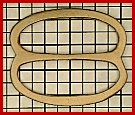

Los Adaes, ca. 1720-1750
Named for the site of the Louisiana's presidio of Los Adaes (1721-1773)—the first capital of Spanish Texas—where examples of the typology have been recovered, members of the LOS ADAES cast brass military buckle cluster have flat profiles and faces, straight or beveled edges, and half-oval (never recurvate) inner frame contours. The examples shown above represent variations encounted within the range of this type's attributes. The center example was recovered in eastern Florida; the smaller strap buckles at left and right are from the Los Adaes site.
 |
Los Adaes Small Strap Buckle Subtypes These nearly identical and very small strap buckles, which were recovered from Pensacola, Florida, fall within the temporal and fabrication attribute criteria assigned to members of the LOS ADAES cluster and are here tentatively included within that typology as the CALLE FUERTE ANTIGUO subtype. Both examples shown retain their original cast brass tines. |
|
Punta Sigüenza, ca. 1730-1780 An example of the small cast brass strap fastener form shown at right was included in the assemblage of artifacts excavated at the site of Santa Rosa Pensacola (1723-1752); others have been recovered from wrecksites of the 1733 Spanish treasure fleet, the city of Pensacola, and the site of Gálveztown, Louisiana (established 1779). A very similar example was also recovered during excavations at the fortification of El Morro in San Juan, Puerto Rico, in 1961.This buckle form is exceptionally well made and finished and imparts a deceptively later appearance than evidenced by its known and widely distributed provenances of discovery. The classification's members feature well-formed, rectangular outer frame configurations with recessed, rectangular center bars as shown in the lateral views presented. Examples studied do not bear evidence of the buckles ever having had tongues/tines, and in all probability served as sliding or adjustable friction fasteners rather than buckles in a conventional sense. The quality of their fabrication suggests peninsular Spanish manufacture. |
 |
Unclassified Ovoid Buckle Forms Ovoid/ovalized "figure 8" or "spectacle" shaped buckle forms remained popular with the Spanish military establishment from the late medieval period into the 19th century. The forms shown here probably served as musket, fusil, or carbine sling buckles. The example on the far right in the illustration at right is of the ca. 1700-1750 period. The example shown at far left, which is well finished on its outer surface but has coarse file abrasion scars on its reverse face like those seen on Gálvez type examples shown later on this page, is of the ca. 1780-1820 period. |
 |
Embellished Oval Strap Buckle This presently unclassified double-frame Spanish strap buckle is a contemporary of the early beveled buckle forms shown at the top of this section and falls within a ca. 1700-1750 temporal range. Its incised embellishments, though simple, combine with its relatively skillful quality of fabrication and finishing characteristics to suggest that this may have been made for and used by an officer. Its center bar originally mounted an iron tongue. A virtually identical example was recovered from the wrecksites of the 1715 treasure fleet. |
 |
Heavy Cast Small Strap Buckles, Ca. 1700-1750 These robust forms may have served as harness strap/saddlery or small accoutrement buckles. Concentrated in Spanish West Florida, the SAN MIGUEL (shown at far left and right in the accompanying photograph) features beveled inner and outer edges and a "Figure 8" configuration. The other, unclassified type at center is of the same period. |
 |
Unclassified Strap Buckles, ca. 1750-1790 These "A"-frame shaped double frame cast brass strap buckles once mounted iron tines on their center bars. Examples encountered feature moderately beveled edges and rounded or flattened obverse faces. Yet to be more fully interpreted, these functioned as military strap or accouterment buckles. |
 |
Nueva Orleans, ca. 1760-1780 Similar to some British belt and strap buckles of the period, these Spanish double frame buckles have one oval loop and one extended, "D"-shaped loop; these oval-D types appear to have been introduced just prior to or at the time that Spain evacuated Florida in 1763 and, soon thereafter, occupied Louisiana. They were phased out of use during the period of the American War for Independence. |
|
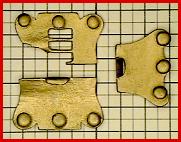 |
Cast Neck Stock Hasps, Ca. 1750-1790 These heavy cast brass adjustable hasps fastened the cravats or neck stocks of linen (or, more rarely, leather) that encircled Spanish soldiers' necks during the mid-to-late eighteenth century. Secured to the ends of their neck stocks by the raised studs shown, these examples almost certainly (and uncomfortably) adorned the necks of enlisted men. Officers' examples had articulated chapes (hinged hasp and tines/tongues) or were more delicately constructed. |
Silver Neck Stock Hasp, Ca. 1760-1780 Recovered in Athens, Texas, this female portion of an officer's or gentleman's neck stock hasp was fashioned from sheet silver and engraved with decorative designs that have a distinctly Spanish Colonial/Mexican character. The cast silver fastening studs were peened into prepared holes in the upper, scalloped edge of the hasp section; two of these studs' reverse faces are engraved with the initials "C S". |
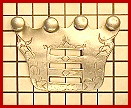 |
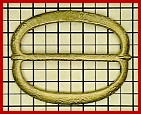 |
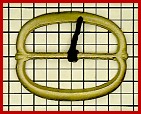 |
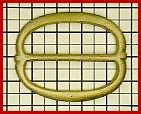 |
Fernandina, Ca. 1760-1785 Found in Spanish military contexts in Florida and Louisiana, this double ovate and knob-tipped waist or shoulder belt buckle form is very similar to examples recovered from British and American military sites of the American Revolutionary period from New York to Virginia. It is probable that all of these buckles comprised variations of a popular form commonly made for and used by the military establishments of Britain, Spain, and what would later become the United States during the late eighteenth century. Its quality of workmanship suggests European manufacture. |
||
|
|
Oval Belt or Strap Buckle, Ca. 1770-1800 Recovered in New Orleans, Louisiana, this oval flat and sturdy but indifferently crafted Spanish military strap or belt buckle once hosted an iron tongue on its center bar. Of lost wax cast brass, the buckle's unmodified sprue removal point is clearly visible as an unsightly scar on the artifact's edge as shown in the photograph at left. Its attributes of manufacture suggest that this example may have been locally manufactured. |
Grenadero, Ca. 1760-1790 Named for the men who wore them, these buckles were worn on the wide shoulder straps of grenadiers in the Spanish military establishment. Similar to other such buckles worn by other European armies, these examples bear more subtle than overt evidences of their Spanish pedigrees. The buckle form shown here was phased out of use at or near the close of the eighteenth century. |
|



Early Spanish Shoe Buckles
A general "rule of thumb" for shoe buckle forms is that the smaller they are, the earlier they are. These Spanish military shoe buckles of the ca. 1710-1730 period exhibit generally similar attributes, the example on the left (Pensacola, Florida) having squared outer frame contours and that on the right (Los Adaes, Louisiana) having rounded outer frame contours with incurvate ends. The center example, from St. Marks, Florida, exhibits a beveled frame and, like the other examples shown, recurvate inner frame contours. This example still possesses its original articulating hasp, though its tongue is absent. In most cases, such buckles are incomplete when recovered. These closely resemble French shoe buckles of the period.
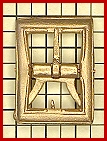 |
Rectangular Shoe Buckle, Ca. 1740-1760 Deviating from the ovate/recurvate frame contours encountered on most Spanish military shoe buckles after 1720, this rectangular example has ribbed outer and inner frame edges and may have belonged to an officer (who would have had much more freedom to use non-standard patterns of buckles and trim than his enlisted counterparts) or a civilian. Its other manufacturing attributes are typically Spanish in character. |
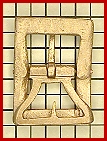 |
Ca. 1730-1750s Shoe Buckle Frames By the 1730s, Spanish military shoe buckles of the land services had assumed the configurations that they would retain for half a century, although they would increase somewhat in overall size as time passed. This classic Spanish military shoe buckle frame configuration featured a rounded rectangular to ovate outer buckle frame contour and a gently recurvate inner frame contour. The example at left is an officer's shoe buckle frame from the site of Santa Rosa Pensacola, while that at right is an enlisted issue version of the same general pattern and period of use. |
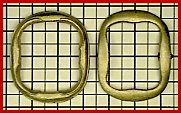 |
 |
Ca. 1740-1785 Shoe Buckles and Frames Growing larger and heavier in construction through time, Spanish army shoe buckles varied from very crude to exceptionally well crafted in construction. A complete and very crudely made example is at left; at right are shown a variety of Spanish military shoe buckle frames. Particularly unusual is the lower left example from the site of Gálveztown, Louisiana (founded 1779) with knobby inner frame protrusions. |
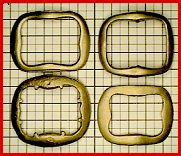 |
 |
Ca. 1760-1785 Shoe Buckle Frame This example is presented to illustrate classic Spanish military shoe buckle manufacturing attributes of the latter portion of the eighteenth century. The ovate outer and recurvate inner frame contours, first seen as early as ca. 1715, is retained through the 1780s. The obverse portion (left) of the frame is well finished and polished; however, as with other Spanish buckles of the period, the reverse face (right) was concealed from view and was left in an unfinished state when it was issued. Note the file or carving tool abrasion scars and sprue removal spot shown. The abrasion scars were made during the fabrication of the original wax master from which the brass buckle frame was cast. |
 |
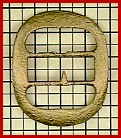 |
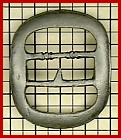 |
 |
Triple Frame Shoe Buckles Retaining the general contours of other Spanish military shoe buckles of the ca. 1760-1785 period, the examples shown represent a uniquely Spanish attempt—first seen at the dawn of the 18th century—to construct a triple frame shoe buckle with one barbed crossbar element and one crossbar element to which was affixed the buckle's tine or tongue as a means of constructing a simplified design with no articulating, pin-mounted internal parts. The example in the center is of a white metal alloy and was recovered from a 1779 Spanish encampment. The broken and complete brass examples shown are both of the period immediately prior to and through the American War for Independence. |
||
Large Rectangular Shoe Buckle Frame, Ca. 1785-1800 This long and slender form represents a terminal style of Spanish military shoe buckle. Following the period of the American War for Independence, the traditional ovate-recurvate form of Spanish military shoe buckle frame was abandoned in favor of this plainer and much larger style. File or abrasion scars typically appear on the reverse of this type's frame. Examples have been observed from Louisiana to Florida. Oversized shoe buckles were also components of civilian fashion as the popularity and use of men's shoe buckles waned into obsolescence during the period of and immediately following the French Revolution. |
|
Above: This subtype's iron or brass tine was mounted like those of most of its European counterparts: on the buckle's center bar, extending to its outer frame edge. Large and small variations of this form are shown. No small examples of the notched frame types shown at right have been observed, and it is possible that the small buckle type shown here was used in conjunction with all the Gálvez subtypes. |
Gálvez, ca. 1780-1820 This family of belt and strap buckles consists of three closely related double framed subtypes separated typologically by their tongue placement configurations. Each has a rectangular outer frame with rounded corners and coarse abrasion scars on its reverse face, which is heavily beveled along its inner frame edges (see illustration at lower right). Introduced by 1780, these Spanish regular military issue buckles remained in use until the end of the American colonial period. |
The most commonly encountered subtype (above and below) has a single looped wire tine extending from a notch on its outer frame across its center bar.
|

The minority subtype above features two, rather than one, frame notches and wire tongues. |
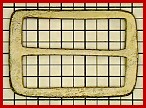 |
Waist or Shoulder Belt Buckle, Ca. 1780-1820 Though similar to the Gálvez types shown above and believed to share approximately the same temporal placement, this cast brass frame buckle deviates considerably in fabrication details from the aforementioned typology. It has a flat, rather than gently rounded, obverse face and it lacks the abrasion scars on its reverse side that characterize members of the Gálvez typology. This was recovered in southern Louisiana. |
"Belly Box" Buckles, Ca. 1780-1820 The "belly box" was a waistbelt-mounted cartridge pouch worn during the eighteenth and early nineteenth centuries. These rectangular buckles fastened Spanish military "belly box" assemblies. Note the heavy guage plain wire tines on the example at right; this simple tongue form comprises a characteristic attribute of Spanish military buckle types for over a century, having seen use by the 1720s through the end of the Spanish colonial period. |
 |
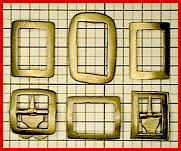 |
Knee Buckle Varieties, Ca. 1740-1800 Knee buckles fastened cloth straps that secured the bottoms of the knee-length breeches that remained fashionable until the early nineteenth century in the Spanish military establishment. A grouping of cast brass Spanish military knee buckles is shown at left; the most common form, classified as the SAN CARLOS type and shown in the illustration's upper left, upper right, and lower center positions, had squared to slightly rounded corners and iron articulating parts (which are nearly always absent from excavated examples). |
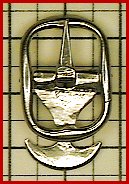 |
Silver Knee Buckle, Ca. 1720-1750 Shown in enlarged scale to illustrate construction details, the components of this small, military pattern knee buckle were cast in solid silver and assembled utilizing a brass hinge pin. Recovered from a site that was subjected to intensive Spanish military activity immediately prior to and during General James Oglethorpe's 1740 invasion of Florida, the high platinum content of the metal (a characteristic of Mexican silver) suggests that this artifact may have been made in Mexico. |
 |
Small Strap Buckle Types Shown here is a group of very small Spanish strap buckles of the eighteenth to early nineteenth centuries. The examples shown at left and right in the bottom row are garter buckles which secured thin linen or leather straps that, worn just above or below the knee, held the knee or thigh-length stockings of the period in place. The forms shown at left and center of the top row are most commonly encountered within ca. 1790-1820 contexts. |
|
Strap End Buckles These small Spanish strap end buckles are very similar to and often difficult to differentiate from other European buckles of the same general configuration and, like their related counterparts, have been encountered in late seventeenth through early nineteenth century contexts. Buckles like these (whose original iron tines are all absent) adorned the ends of saber and sword straps as well as other adjustable accouterment linkages. |
 |
 |
Sword Belt Buckle, Ca. 1808-1814 Missing one of its two identical oval belt retaining elements, this cast brass serpentine "S"-hooked buckle, though of Spanish usage, was almost certainly made by the English during the 1808-1814 period of the Anglo-Spanish alliance against the forces of Napoleonic France. These saw use by Spanish officers in Europe as well as throughout Spain's colonies in the New World. Some of these, captured from or left behind by Spanish forces in New Spain, were worn by Mexican military units as late as the Mexican-American War (1846-1848). The example shown was recovered, along with numerous Spanish 1757 and 1789 pattern fusil parts, in construction debris in Pensacola, Florida. |
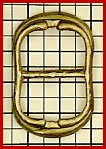 |
Embellished Strap Buckles, Ca. 1775-1800 These moderately embellished and very similar ovoid buckles were recovered from the sites of Gálveztown, Louisiana (left) and near St. Augustine, Florida (right) respectively and occupy a temporal placement within the last quarter of the eighteenth century. These were probably used by officers as sabretache buckles. The sabretache was a shoulder-mounted strap attached to a waist belt from which a sword was suspended. Its function was to reinforce the sword belt and keep it from sagging down on the side of the waist on which the sword or saber was suspended. The example at left once mounted an iron tine which is now absent; the original brass tine of the example at right is still intact. |
|
Lion's Head Strap Buckle, Ca. 1808-1814 Probably serving as a sabretache buckle, this originally gilded cast brass accessory was recovered from a late Spanish colonial military occupation site in northwest Florida. Only a small mound of corrosion remains of its original center bar mounted iron tongue. Like the sword belt buckle shown above, this was in all probability a product of English manufacture for the Spanish military establishment during the Napoleonic period. |
 |
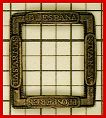 |
Spanish Patriotic Buckle, Ca. 1780-1800 Closing this section is a unique, large Spanish patriotic knee buckle frame (or, possibly, a small shoe buckle frame) in the collection of the Pensacola Historical Society. Of stamped brass foil with a white metal alloy core, this example's edges are embellished with small text frames enclosing, in sections, the phrase "VIVAN Y PROSPEREN LAS ARMAS DE ESPAÑA" ("Live and Prosper the Arms of Spain"). |
Acknowledgments:
Jim R. Baldwin; Chris Bennett; City of St. Augustine
Department of Archaeology; René Chartrand; David Fisher; Florida Museum of Natural
History; Lester Girlinghouse; Eugene Gruenewald; Rock Hard; Daniel Jenkins; John Joline; John and
John Kolodziej; Bill R. Logan; Dudley and Elaine Minton; Pensacola Historic Preservation
Board; Pensacola Historical Society; Darrell Smith; Arthur, Imogene, and Samuel Standard;
Bennett and Martha Tillison; Linda and Calvin Wiggs; and Williamson Museum, Northwestern State University, Louisiana State
Division of Archaeology, Los Adaes SCA.